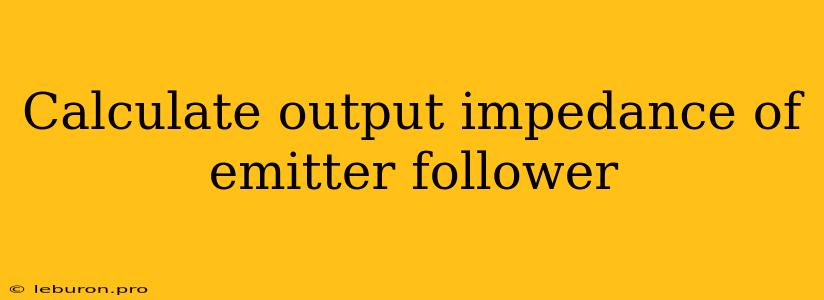The emitter follower, also known as a common-collector amplifier, is a fundamental circuit in electronics known for its high input impedance, low output impedance, and unity voltage gain. Its primary application lies in impedance matching, buffering signals, and providing current gain. Understanding the output impedance of an emitter follower is crucial for optimizing its performance and ensuring proper operation within a larger circuit. This article will delve into the theoretical foundation and practical aspects of calculating output impedance in emitter followers.
Understanding Output Impedance
Output impedance is a crucial parameter that describes a circuit's ability to deliver current to a load. It represents the internal resistance of the circuit as seen by the load. A lower output impedance indicates that the circuit can supply current to the load with minimal voltage drop, leading to greater efficiency and less signal degradation. In contrast, a higher output impedance implies that the circuit is less capable of driving the load effectively, resulting in a larger voltage drop and potential signal distortion.
Calculation Methods
Several methods are employed to calculate output impedance in an emitter follower. Two primary approaches include:
1. Small-Signal Analysis
This method involves analyzing the circuit using small-signal models, replacing the transistors with their small-signal equivalents. The output impedance is derived from the ratio of output voltage change to the corresponding change in output current, while keeping the input voltage constant.
Small-Signal Model
The small-signal model for a bipolar junction transistor (BJT) consists of:
- Transconductance (gm): Represents the change in collector current for a given change in base-emitter voltage.
- Output Resistance (ro): Represents the resistance between collector and emitter in the active region.
- Input Resistance (rπ): Represents the resistance between base and emitter.
Output Impedance Formula
For an emitter follower with a BJT, the output impedance (Zout) can be approximated as:
Zout ≈ 1 / (gm + 1/ro)
gm and ro are the transconductance and output resistance of the BJT, respectively.
2. Experimental Measurement
In a practical setting, output impedance can be measured using a signal generator and an oscilloscope.
Experimental Procedure
- Connect the emitter follower to a signal generator and a load resistor (RL).
- Apply a known voltage (Vin) to the input of the emitter follower.
- Measure the voltage across the load resistor (Vout).
- Calculate the load current (IL) by dividing Vout by RL.
- Vary the load resistor and measure the corresponding load current changes.
- Plot the load current (IL) against the load voltage (Vout).
- Determine the slope of the resulting curve. The reciprocal of the slope represents the output impedance.
Factors Influencing Output Impedance
Several factors affect the output impedance of an emitter follower:
- Transistor Characteristics:
- Transconductance (gm): Higher gm leads to lower output impedance.
- Output Resistance (ro): Higher ro leads to lower output impedance.
- Emitter Resistor (RE):
- A larger RE results in higher output impedance.
- Load Resistance (RL):
- Lower RL leads to higher output impedance.
Advantages of Low Output Impedance
A low output impedance in an emitter follower offers numerous advantages:
- Improved Signal Transfer: Minimal voltage drop across the output impedance ensures efficient signal transfer to the load.
- Reduced Signal Distortion: Minimizes the impact of load variations on the output signal, leading to better signal integrity.
- Increased Power Efficiency: Minimizes power loss in the circuit, improving overall system efficiency.
- Improved Noise Performance: Lower output impedance reduces noise injection from the load into the emitter follower.
Conclusion
Output impedance is a critical factor influencing the performance of emitter followers. Understanding and calculating this parameter is crucial for designing efficient and reliable circuits. This article has discussed various methods to calculate output impedance, highlighting the influence of transistor characteristics, external components, and load resistance. By optimizing output impedance, designers can ensure efficient signal transmission, minimize distortion, and improve overall circuit performance. The knowledge gained from this article can help engineers and technicians in effectively designing and analyzing emitter follower circuits for a wide range of applications.
